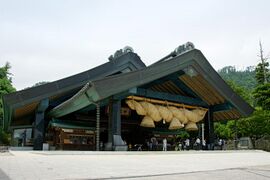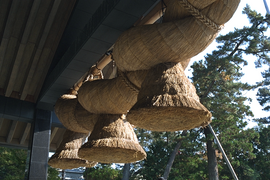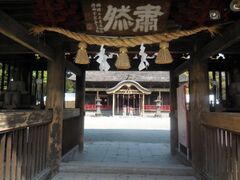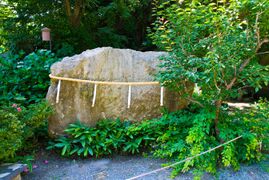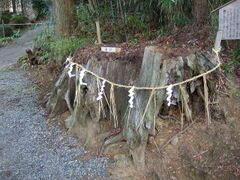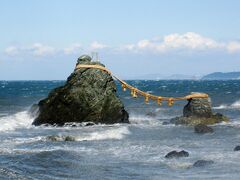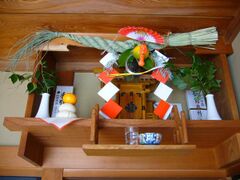Religion:Shimenawa
| Script error: The function "transl" does not exist. | |
|---|---|
| しめ縄 | |
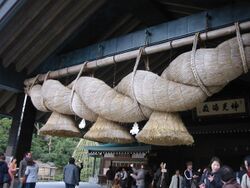 | |
| Material | Hemp fiber/Straw |
| Present location | Japan |
| Culture | Shinto |
Lua error in Module:Lang/utilities at line 268: attempt to call field '_transl' (a nil value). are lengths of laid rice straw or hemp[1] rope used for ritual purification in the Shinto religion.
Script error: The function "transl" does not exist. vary in diameter from a few centimetres to several metres, and are often seen festooned with Script error: The function "transl" does not exist.—traditional paper streamers. A space bound by Script error: The function "transl" does not exist. typically indicates a sacred or ritually pure space, such as that of a Shinto shrine.[2] Script error: The function "transl" does not exist. are believed to act as a ward against evil spirits, and are often set up at a ground-breaking ceremony before construction begins on a new building. They are often found at Shinto shrines, Script error: The function "transl" does not exist. gates, and sacred landmarks.
Script error: The function "transl" does not exist. are also placed on Script error: The function "transl" does not exist., objects considered to attract spirits or be inhabited by them. These notably include being placed on certain trees, the spirits considered to inhabit them being known as Script error: The function "transl" does not exist.. Cutting down these trees is thought to bring misfortune. In the case of stones considered to be inhabited by spirits, the stones are known as iwakura (磐座/岩座).[3]
A variation of the Script error: The function "transl" does not exist. are worn in sumo wrestling by Script error: The function "transl" does not exist. (grand champions), during the entrance ceremony to debut as grand champion rank. In this instance, Script error: The function "transl" does not exist. used by Script error: The function "transl" does not exist. are seen as being living Script error: The function "transl" does not exist. (a vessel capable of housing a spirit, known as Script error: The function "transl" does not exist. when inhabited by a spirit), and are therefore visually distinguished as "sacred".
Shinto
Origin of Script error: The function "transl" does not exist.

The prototype of Script error: The function "transl" does not exist. in Shinto is a rope of Amaterasu, Japan's "Heaven-shining great Script error: The function "transl" does not exist.".[4] According to "A popular dictionary of Shinto", Amaterasu hid in a cave called Amano-Iwato after an argument with her brother Susanoo.[4] Therefore, the entire universe lost its luster.[5] Other deities tried numerous ways to attract Amaterasu out of the cave.[5] At the moment that Amaterasu left the cave, the Script error: The function "transl" does not exist. Futo-tama used a magical rope that drew a line of demarcation between her and the cave, to avoid her returning to the cave.[4] The rope became known as a Script error: The function "transl" does not exist.. Because of the Script error: The function "transl" does not exist., the universe returned to its previous state.[5]
Shinto shrines

Script error: The function "transl" does not exist. and nature have been a hallmark of Shinto shrines since in early times. The shrine in Shinto is a place for Script error: The function "transl" does not exist..[6] Local people held rituals in shrines. Early shrines were not composed of classical buildings,[6] with rocks, plants and Script error: The function "transl" does not exist. instead marking their boundaries,[6] as part of the Shinto respect for nature. In Shinto, all the sacred objects and nature were personified.[6] Even a sword from a deceased Japanese warrior could be seen as the god because of its internal spirit and sense of awe.[7] In modern-day society, there are still some sites that use Script error: The function "transl" does not exist. to demarcate boundaries, such as the Nachi Falls in Kumano.[6] A rock in Ise Bay is still connected by Script error: The function "transl" does not exist. as well.[6]
Types

Script error: The function "transl" does not exist. usually appear in a shape similar to a twisted narrow rope with various decorations on it.[4] Zig-zag paper and colorful streamers called Script error: The function "transl" does not exist. commonly decorate Script error: The function "transl" does not exist..[4] The size of Script error: The function "transl" does not exist. differs from simple to complicated. In shrines, they are usually tapered and thick with a diameter of 6 ft (1.8 m).[4]
Decorations
Script error: The function "transl" does not exist. are decorated differently depending on the intended blessing and meaning.
- Script error: The function "transl" does not exist.: a kind of bitter orange used to decorate Script error: The function "transl" does not exist.. This combination is seen to bring good fortune and prosperity.[8]
- Script error: The function "transl" does not exist. or Script error: The function "transl" does not exist.: folded white paper which stands for lightning, a symbol of fertility.[9]
- Pine twigs: using pine twigs to decorate Script error: The function "transl" does not exist. has a meaning of healthy growth for the next generation, as well as longevity of the elderly.[8]
Biggest Script error: The function "transl" does not exist. in Japan
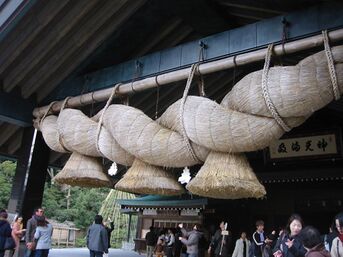
The biggest Script error: The function "transl" does not exist. in Japan is located at Izumo Taisha Grand Shrine,[8] which occupies over 27,000 m2 (290,000 sq ft) of land in Japan. The Script error: The function "transl" does not exist. is 13.5 m (44 ft) in length and 8 m (26 ft) in width and was made by more than 800 indigenous people in Japan.[8]
Use
In Mountain Opening Ceremony
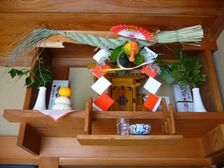
Script error: The function "transl" does not exist. are used in Japan's Mountain Opening Ceremony, which is held every May 1.[5] There are over 100 Shinto believers who participate in this ceremony.[5] It is a 2-hour journey that they climb from Akakura Mountain Shrine to Fudō Waterfall.[5] The overall purpose is to carry the Script error: The function "transl" does not exist. and fix it between two towering trees.[5] When the ceremony is finished, people get together and celebrate.[5]
In New Year's Celebration
In Japan's New Year celebration, ornaments such as Script error: The function "transl" does not exist. decorate every household. During this time period, local residents usually hang it on the door in order to drive away evils.
Script error: The function "transl" does not exist.
Script error: The function "transl" does not exist. are used in Script error: The function "transl" does not exist., Japan's Naked Festival.[4] This festival has been held during the New Year period for more than 500 years.[4] The festival's participants, who are all young men, wear nothing but a fundoshi in cold weather in order to show their strength and manliness.[4] It also includes various activities such as 'jostling, climbing fighting with a wooden ball' as well as being sprayed with water.[4] Sometimes these festivals are held in Shinto shrines.[4] The participants put Script error: The function "transl" does not exist. on the roof to wish them good luck for the upcoming year.[4] Script error: The function "transl" does not exist. are presented to the Script error: The function "transl" does not exist. as a sacrifice in the shrine on New Year's day.[4]
In sumo
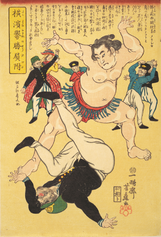
Sumo, Japan's traditional national sport,[4] still involves some elements of Shinto.[4] Sumo matches are held in Shinto shrines, where the arena is demarcated by Script error: The function "transl" does not exist..[4] Moreover, the champion of the sumo has to wear Script error: The function "transl" does not exist. around his waist in order to attend a victorious ceremony called Script error: The function "transl" does not exist..[10]
Construction
Material and preparation process

Hemp fiber is the basic material used in the production of Script error: The function "transl" does not exist., and has been used since ancient times.[10] In Shinto, hemp is regarded as a sacred food with a meaning of purity and fertility.[10] After the Cannabis Control Act of 1948, when the growing of hemp was banned,[10] straw began to be used instead as the raw material of Script error: The function "transl" does not exist..[11] During the process of production, the straw stems are harvested between 70 and 80 days of growth, as beyond this, the quality of the fibre decreases as the plant starts to produce its seeds.[11] After the Script error: The function "transl" does not exist. straw is collected by machine, it is heated for more than 10 hours, to avoid the stems being dried by the sun.[11] The best stems are then chosen by hand in order to create Script error: The function "transl" does not exist..[11]
Related objects
Script error: The function "transl" does not exist.
Script error: The function "transl" does not exist. (also called Script error: The function "transl" does not exist. or Script error: The function "transl" does not exist.), a vertical wooden stick decorated with Script error: The function "transl" does not exist., cloth or metal called Script error: The function "transl" does not exist., usually in red or white, which is used priests in Shinto.[4] People put Script error: The function "transl" does not exist. in front of Script error: The function "transl" does not exist. doors.[4] In a procession called shinkō-shiki , Script error: The function "transl" does not exist. are seen as a sacrifice for the gods or a symbol of the existence of the gods.[4] In ancient times, people offered cloth to the Shinto shrines, similarly to today's processions.[4] Script error: The function "transl" does not exist. are also sometimes used in the way Script error: The function "transl" does not exist. are.[4] The stripes can also hang on the Script error: The function "transl" does not exist..[4]
Script error: The function "transl" does not exist.
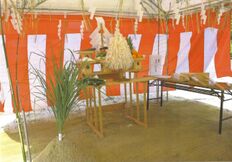
Script error: The function "transl" does not exist. are the sacred spaces delimited by Script error: The function "transl" does not exist.,[4] which sometimes feature a cherry blossom tree surrounded by green plants appears, symbolising the seat of the gods.[4]
Script error: The function "transl" does not exist.
Like Script error: The function "transl" does not exist., Script error: The function "transl" does not exist. are also a New Year's decoration in Japan,[4] consisting of a Script error: The function "transl" does not exist. decorated with items related to rice like rice-cakes.[4] The purpose of the Script error: The function "transl" does not exist. is to bring good fortune to people.[4]
Script error: The function "transl" does not exist.

Script error: The function "transl" does not exist. are a reduced version of Script error: The function "transl" does not exist. used in daily life,[4] and are thought to control rice, salt, and water which could bring people good luck.[4] Therefore, it always appears in the business area such as restaurants as well as conventional industries.[4] Places like the police stations and board ships will also feature Script error: The function "transl" does not exist..[4]
Raijin
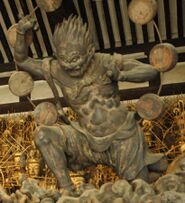
Raijin is the Script error: The function "transl" does not exist. of thunder who also has power over drought.[4] According to "A popular dictionary of Shinto", there is a custom in Japan which talks about Script error: The function "transl" does not exist. and Raijin.[4] Local residents in Japan's Kantō area put a Script error: The function "transl" does not exist. between green bamboo after a bolt of lightning appears on the planted rice field out of gratitude to Raijin.[4]
Script error: The function "transl" does not exist.
A Script error: The function "transl" does not exist. is a sacred tree located in a Shinto shrine sometimes indicated by Script error: The function "transl" does not exist..[4] It also be seen as a god's Script error: The function "transl" does not exist..[4] These trees surrounding the shrine are seen as part of the shrine itself.[4]
Script error: The function "transl" does not exist.

Script error: The function "transl" does not exist. are an archway composed of two round posts and two upper cross-beams.[4] The ends of the cross-beams are typically curved, which is a symbol of a style called Script error: The function "transl" does not exist..[4] There is an under-cross-beam just below the top individually.[4]
Script error: The function "transl" does not exist. first appeared in Japan at the time Chinese culture and Buddhism were introduced,[4] though their exact origin, including the origin of their shape and name, is unknown;[4] some researchers believe the name Script error: The function "transl" does not exist. to have originally come from Sanskrit.[4]
With the exception of the cross-beams, people also use Script error: The function "transl" does not exist. to decorate Script error: The function "transl" does not exist..[4] The type of Script error: The function "transl" does not exist. using only Script error: The function "transl" does not exist. as cross-beams is known as Script error: The function "transl" does not exist., which consist of only two posts and a Script error: The function "transl" does not exist.; these Script error: The function "transl" does not exist. are intended to be temporary instead of permanent.[4]
In Japan, there are more than 20 different kinds of Script error: The function "transl" does not exist., varying from simple wood constructions to those made of concrete gates, typically used as gates to Shinto shrines.[4] The style of Script error: The function "transl" does not exist. is not strictly based on the style of shrine, and there could be more than one style of Script error: The function "transl" does not exist. in one shrine.[4]
Similar to Script error: The function "transl" does not exist., Script error: The function "transl" does not exist. also have meaning in Shinto, representing a gate to the world, people, or any relationship.[7] The purpose of Script error: The function "transl" does not exist. and Script error: The function "transl" does not exist. is the same, in bringing lost people to the Script error: The function "transl" does not exist.-filled world.[7]

In art
During the 2017 Yokohama Triennale, Indonesian artist Joko Avianto's artwork, "The border between good and evil is terribly frizzy", was displayed in the center of the hall in the Yokohama Museum of Art.[12] The name, taken from the quote "The border between good and evil is terribly fuzzy" by Czech novelist Milan Kundera,[12] changed 'fuzzy' to 'frizzy' because of the twisted, Script error: The function "transl" does not exist.-inspired shape of his artwork.[12] Avianto took the meaning of Script error: The function "transl" does not exist. to separate 'the sacred and the profane', or 'the ideal and the secular',[12] as inspiration in his work, using it to symbolise the boundary between 'the earth and heaven'.[12]
Script error: The function "transl" does not exist. production in Taiwan

Taiwan's Miaoli County began to produce Script error: The function "transl" does not exist. for export to Japan in 1998.[11] In the late 1990s, Japanese manufacturers visited Taiwan and found the high quality of straw as well as the relatively low cost of producing it.[11] However, as there were no local residents who knew how to make Script error: The function "transl" does not exist.,[11] the Japanese started to provide free classes for them to study the skills for producing Script error: The function "transl" does not exist..[11] The Script error: The function "transl" does not exist. industry in Taiwan developed rapidly,[11] with many large Script error: The function "transl" does not exist. factories appeared in Taiwan in the late 1990s. However, due to industrial disruption, most factories were forced to shut down a few years later, and only one factory was left to continue production.[11] Other remaining factories chose to hand over the work to other Southeast Asian countries, particularly Vietnam, for a lower cost production.[11] Later in 2005, a large number of Script error: The function "transl" does not exist. orders were transferred back to Taiwan because buyers in Japan found that the quality of Script error: The function "transl" does not exist. produced in Vietnam was poorer compared to those produced in Taiwan.[11]
The craftsmen in Taiwan harvest the straw to make Script error: The function "transl" does not exist., while Japanese manufacturers provide samples or finished products to the customers according to their orders.[11]
Image gallery
See also
- Script error: The function "transl" does not exist., household Shinto shrines
- Script error: The function "transl" does not exist. – a custom utilizing Script error: The function "transl" does not exist.
- Script error: The function "transl" does not exist., traditional Japanese braided cord
- Script error: The function "transl" does not exist.
References
- ↑ "Mie gov't rejects cannabis cultivation request for Shinto rituals". https://www.japantoday.com/smartphone/view/national/mie-govt-rejects-cannabis-cultivation-request-for-shinto-rituals.
- ↑ Cf. Kasulis (2004:17-23).
- ↑ "Shimenawa & Rock", More glimpses of unfamiliar Japan, Thursday, March 18, 2010
- ↑ 4.00 4.01 4.02 4.03 4.04 4.05 4.06 4.07 4.08 4.09 4.10 4.11 4.12 4.13 4.14 4.15 4.16 4.17 4.18 4.19 4.20 4.21 4.22 4.23 4.24 4.25 4.26 4.27 4.28 4.29 4.30 4.31 4.32 4.33 4.34 4.35 4.36 4.37 4.38 4.39 4.40 4.41 4.42 4.43 4.44 4.45 4.46 Bocking, Brian (1995). A Popular Dictionary of Shinto. Richmond, Surrey, U.K.: Curzon Press.
- ↑ 5.0 5.1 5.2 5.3 5.4 5.5 5.6 5.7 Swanson, Paul L (2004-05-01). "Review of: Ellen Schattschneider, Immortal Wishes: Labor and Transcendence on a Japanese Sacred Mountain". Japanese Journal of Religious Studies. doi:10.18874/jjrs.31.1.2004.232-233. ISSN 0304-1042.
- ↑ 6.0 6.1 6.2 6.3 6.4 6.5 Evans, Marcus (2014-05-01). "Shinto: An Experience of Being at Home in the World With Nature and With Others". Masters Theses & Specialist Projects. https://digitalcommons.wku.edu/theses/1343.
- ↑ 7.0 7.1 7.2 Kasulis, Thomas P. (2004-08-31). Shinto. University of Hawaii Press. doi:10.1515/9780824864309. ISBN 978-0-8248-6430-9. http://dx.doi.org/10.1515/9780824864309.
- ↑ 8.0 8.1 8.2 8.3 Forlano, Laura, ed (2019). Bauhaus Futures. The MIT Press. doi:10.7551/mitpress/12044.001.0001. ISBN 978-0-262-35492-9. http://dx.doi.org/10.7551/mitpress/12044.001.0001.
- ↑ Jiao, Yupeng (2020-11-17). "Rural Wandering Martial Arts Networks and Invulnerability Rituals in Modern China". Martial Arts Studies (10): 40. doi:10.18573/mas.109. ISSN 2057-5696.
- ↑ 10.0 10.1 10.2 10.3 Price, Stephanie (2020-09-11). "Cannabis, hemp, CBD: the Japanese cannabis landscape" (in en-GB). https://www.healtheuropa.eu/the-japanese-cannabis-landscape/102645/.
- ↑ 11.00 11.01 11.02 11.03 11.04 11.05 11.06 11.07 11.08 11.09 11.10 11.11 11.12 China (Taiwan), Ministry of Foreign Affairs, Republic of (2009-02-01). "Hanging in There" (in en). https://taiwantoday.tw/news.php?unit=8&post=12846.
- ↑ 12.0 12.1 12.2 12.3 12.4 "Joko Avianto at the Yokohama Triennale 2017. Nafas Art Magazine" (in en). https://universes.art/en/nafas/articles/2017/joko-avianto.
Further reading
- Kasulis, Thomas P. (2004). Shinto: The Way Home. University of Hawaii Press. ISBN:0-8248-2794-5.
External links
- "Shimenawa" in Encyclopedia of Shinto
 |
